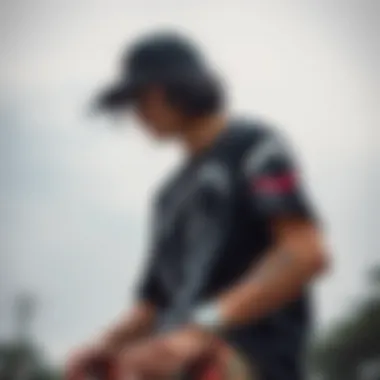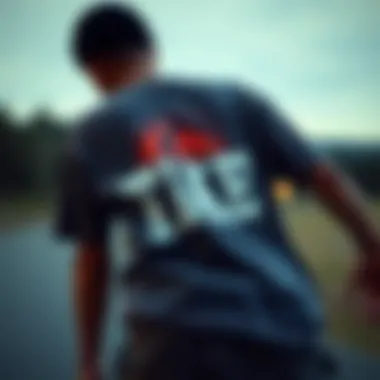Exploring the Impact of Novel Tees in Skate Culture


Intro
Skate culture is a fascinating tapestry of creativity, individuality, and rebellion. Central to this vibrant community is a unique artifact of expression: the novel tee. While it may seem like just an article of clothing, the t-shirt often serves as a canvas for identity and style within the skateboarding world. This article will peel back the layers surrounding the significance of the novel tee, investigating how it intertwines with the history of skateboarding and reflects the ethos of the skater lifestyle.
As skateboarding has evolved from a fringe activity into a global phenomenon, so too has the fashion surrounding it. The relationship between the cloth we wear and the tricks we perform may not be immediately apparent, but delve deeper and you'll find that each design and every brand tells a story. Whether it’s a tee adorned with eye-catching artwork or one that’s more understated, the choice of attire precedes social interactions and scene acceptance. Here we will explore various key aspects of this t-shirt trend in the skate scene.
Understanding the Concept of Novel Tee
The phrase "novel tee" refers to more than just a t-shirt; it embodies a cultural phenomenon steeped in individuality and expression within the skateboarding community. Understanding this concept is vital for grasping the broader implications of apparel within skate culture. The novel tee serves as a canvas for creativity, not only showcasing artistic designs but also communicating ideas and values that resonate deeply with skaters.
Skateboarding is fundamentally about freedom—be it on the board or in self-expression. As a result, the importance of novel tees lies in their ability to merge aesthetics with functionality. Many skaters view these shirts as an extension of themselves, where every graphic or stitch tells a story. This article aims to illuminate the various aspects of novel tees, emphasizing how they are intricately linked to the identity, culture, and even the politics of the skateboarding world.
Defining Novel Tee
The term "novel tee" encompasses a diverse range of t-shirt designs that stand out from the usual fare. These are often characterized by unique graphics, engaging typography, and innovative cuts. More often than not, they reflect the personal style and sensibilities of the wearer.
What makes a tee 'novel' is not merely its visual appeal; it also includes the narrative behind it. Many brands utilize limited runs or collaborations with artists to create something special. This shifts a simple garment into an artifact laden with cultural significance.
Historical Context of Skate Apparel
To fully appreciate the novel tee, one must journey back to the evolution of skate apparel. The roots of skateboarding trace back to the late 1940s and early 1950s when surfers wanted to capture the thrill of wave-riding on land. Initially, clothing was functional—favoring comfort and mobility. However, as the sport gained popularity throughout the 1970s and 1980s, a distinct skate culture emerged, paving the way for innovative designs.
Brands like Vans and Thrasher began creating skate-specific gear that characterized both the sporty and rebellious essence of construction. Novel tees started gaining traction around this time, adorned with bold graphics that conveyed a sense of community, defiance, and artistic flair. In these early days, a t-shirt wasn't just an item of wear; it was a statement of identity.
The Role of T-Shirts in Skateboarding
T-shirts have a central role in skateboarding, acting as more than just casual wear. For many skaters, these shirts symbolize unity within subculture. The act of wearing a specific brand or graphic often signifies allegiance to a particular skate team, locality, or lifestyle.
Moreover, tees serve as the perfect medium for expressing personal narratives or social commentary. A graphic tee might convey a strong message about social issues or represent the voice of the artist that designed it.
"T-shirts did not just become part of skate culture; they became the culture itself, a tapestry woven with stories and beliefs."
Such roles extend beyond mere aesthetics; they shape interactions, fostering connections among skaters. In the hustle and bustle of a skatepark or an urban street, a quick glance at someone’s tee can spark conversation or establish camaraderie.
In summary, understanding novel tees requires an exploration into their definition, historical context, and their pivotal role in skateboarding. These factors intertwine to reveal how these garments do more than cover skin; they embody the heart and soul of a community built on passion and expression.
Fashion and Functionality in Skate Culture
In the world of skateboarding, the balance between fashion and functionality is not just a matter of aesthetics; it’s a fundamental aspect of the sport itself. Skate tees are not merely garments to showcase style; they are specifically designed to meet the needs of skateboarders. Through this intersection, skateboarders express their individuality while also ensuring maximum performance during rides. It’s this marriage of visual appeal and practical application that sets the tone for a thriving culture.
Material Choices for Skate Tees
When it comes to fabric, skateboarders demand a unique blend of comfort, breathability, and resiliency. Cotton remains a popular choice, particularly in its hybrid forms like cotton-polyester blends, which offer a soft touch while maintaining durability. This is crucial since the repetitive motions of skating can put more strain on clothing than one might think. Additionally, moisture-wicking fabrics have emerged as vital components in contemporary designs. These materials effectively draw sweat away from the body, keeping riders cooler and more focused during their tricks.


Some brands, like Supreme and Thrasher, have innovated further by integrating materials like polyester with spandex for greater stretchability. This flexibility is key for dynamic movements that are intrinsic to skateboarding—think about how skaters maneuver their boards with various tricks like ollies and kickflips. The fabric’s elasticity allows for a full range of motion, meaning that a well-made skate tee is one that complements the skater’s rhythm, rather than hinders it.
Design Ergonomics for Movement
The cut and fit of skate tees significantly influence a skater’s experience on the board. Unlike typical casual tees, skate tees often feature a more relaxed fit. This is not just about style; it’s about enhancing movement. A looser fit allows skaters to move freely without restricting their upper bodies. Designs that include raglan sleeves, for instance, provide greater freedom of movement compared to traditional set-in sleeves. This ergonomics-focused approach ensures that there is no fatigue due to tight clothing while landing tricks or going for long sessions.
Moreover, some modern designs incorporate features like extended backs or side vents to enhance ventilation. These small details are crucial when considering the heat generated during an intense skate session. Overall, the design of skate tees reflects a practical approach to fashion that prioritizes functionality without dismissing style.
Durability and Comfort Considerations
For skateboarders, durability is non-negotiable. A tee that frays or rips after a few sessions is not just a disappointment; it can also impede performance. As such, reinforced stitching and high-quality fabric choices are fundamental in making skate tees stand the test of time. The emphasis on durability speaks volumes about the values of the skate community—resilience and endurance are venerated, both in skating and attire.
Comfort is equally important. No one wants to be distracted by an uncomfortable shirt while trying to nail a trick. Breathable fabrics partnered with thoughtful designs that consider chafing and irritation hold significant weight in the purchasing decision for skaters. It’s why you’ll find that brands are often geared toward creating the ultimate skater's silhouette without compromising on comfort.
"A good skate tee speaks to both the heart and the hustle of skating. It's more than just a piece of clothing; it’s a badge of identity on and off the board."
The Aesthetic Appeal of Skate Tees
The aesthetic appeal of skate tees is a vital facet of skateboard culture. It offers not just clothing, but a medium for self-expression, an avenue to showcase creativity, and an essential piece of the lifestyle that defines what it means to be a part of the skateboarding community. Beyond their functional role, these t-shirts serve as canvases for visual storytelling, inviting skateboarders not just to wear their passion but to live it. With unique designs, vibrant colors, and powerful imagery, skate tees become symbols that capture the essence of individuality and collective identity among skaters.
Graphic Design Trends
When it comes to graphic design trends in skate tees, the diversity is as broad as a skateboard park. Designs often reflect personal beliefs, local influences, or even global issues. For example, some artists may blend classic skate graphics with modern aesthetics, pushing boundaries while paying homage to the roots of skate culture. Iconic elements like skulls, retro typography, or abstract patterns often surface, but it’s the growing inclination towards unique narratives that really sets this trend apart. Rather than just graphics for the sake of visuals, many brands focus on creating stories, making every piece a conversation starter.
"In skate culture, the graphic on your tee can say more than any spoken word."
Consider brands like Thrasher or Element, which often employ vibrant yet sometimes controversial designs that defy traditional norms. Moreover, collaborations with underground artists help bring fresh perspectives. They serve as bridges connects between the skate world and the vibrant scenes of street art and music, resulting in tees that embody the energy and spirit of the culture.
Color Theory in Skate Fashion
Color plays an essential role in the aesthetic appeal of skate tees. Not only does it catch the eye, but it also stirs feelings and communicates messages. For instance, the use of bold, saturated colors invokes energy and excitement, which resonates well with the adrenaline-fueled lifestyle of skateboarding. On the other hand, muted tones can evoke a sense of nostalgia or simplicity, often referencing the styles of the past.
Skate brands often mix colors that may seem outlandish together. These unexpected combos resonate with skateboarders, who often live on the edge of societal norms. Understanding color theory helps apparel designers craft designs that don’t just look good but feel authentic and align closely with the skate culture ethos.
Influence of Street Art and Music
Street art and music play crucial roles in shaping not only the designs but also the overall aesthetic of skate tees. Artists often draw inspiration from the textures of urban environments—the graffiti-clad walls of city streets, the sounds that echo through skate parks, and the rhythm of a city alive with energy. The infusion of street art into t-shirt graphics often lends a raw, organic feel that is highly sought after in skate culture.
Meanwhile, the influence of music cannot be overstated. Many skateboarders are part of subcultures that revolve around specific music genres, ranging from punk to hip-hop. The visuals associated with these genres often seep into skate tee designs, leading to a rich interplay of art and sound. Bands and skateboard brands frequently collaborate, creating limited edition tees that resonate with fans on multiple levels.
This reciprocal relationship between art, music, and tee design fuels creativity and fosters a vibrant community. As skateboarders don their tees, they don’t just wear art; they embody a culture where creativity knows no bounds.
Cultural Significance and Identity


The cultural significance of the novel tee in skate culture runs deep, weaving together threads of individual identity, community belonging, and social reflection. It's not merely a piece of clothing; it embodies personal narratives, social connections, and the evolution of a counter-culture. Understanding these elements enhances one's grasp of how skateboarding is more than a sport—it's a lifestyle.
Expressions of Personal Identity
For many skateboarders, the tees they choose are a canvas for self-expression. Each design and graphic resonates with their personal experiences or aspirations. Whether it features a vibrant piece of street art or an obscure band that reflects their musical tastes, these choices allow skaters to communicate who they are without saying a word.
A skateboarder might sport a tee adorned with a local artist’s design, showcasing pride in their roots. This isn’t about fashion alone; it's about signaling values and opinions. In many ways, the act of customizing a tee—adding patches or unique modifications—amplifies this expression. Therefore, an old t-shirt, frayed at the edges, can tell a more compelling story than the trendiest new drop from a high-end brand.
Community and Belonging through Apparel
Skateboarding's culture thrives on a sense of community. Tees often serve as a bridge, connecting individuals to one another. Groups form not only through shared love for skating but also through shared style. Wearing similar apparel creates an unspoken bond among skaters, often leading to friendships that extend beyond the skatepark.
A simple logo on a t-shirt can become the symbol of a collective identity. Take, for instance, the iconic designs from brands like Vans or Thrasher; these logos are not just visible markers of a fashion choice but rather badges of allegiance to a community. Furthermore, local skate shops often produce their limited-edition tees, which become prized possessions among skaters, adding to this feeling of belonging.
"In skate culture, wearing the right tee can be like wearing your heart on your sleeve. It shows where you're from and where you belong."
Fashion as a Reflection of Social Values
The novel tee doesn't just portray personal aesthetic; it also mirrors broader societal ideas and values. Trends often emerge in response to contemporary issues, whether they are social justice movements, environmental concerns, or shifts in music culture. A tee that incorporates eco-friendly materials speaks volumes about the wearer's stance on sustainability, while graphics that feature social commentary reveal an awareness of societal dynamics.
In the current climate, brands that tie in activism with their designs resonate significantly with the skater demographic. A t-shirt emblazoned with a message on climate change or racial justice not only serves as a fashion statement but also as a platform for dialogue. This convergence of style and substance enriches everyone’s understanding of skateboarding as a forward-thinking culture.
The intersection of personal identity, community ties, and socio-political reflection exemplifies the remarkable power of the novel tee in skate culture. This blend of factors enriches the cultural landscape, making skate apparel a unique and vital form of expression that goes beyond the surface.
Sustainable Practices in Skate Apparel
In today's world, sustainability is not just a buzzword; it's a necessity. The skate culture, often associated with a certain rebellious spirit, has started embracing eco-conscious practices. Skateboarders and enthusiasts alike are recognizing the importance of sustainable options, not only for the environment but also for the future of skateboarding itself. As this culture continues to evolve, sustainable practices are becoming a cornerstone in how apparel is created, marketed, and consumed.
Eco-friendly Material Usage
When it comes to skate tees, the materials used play a crucial role. Traditional fabrics like cotton can be resource-intensive, requiring significant amounts of water and pesticides. As awareness grows, more brands are looking towards eco-friendly alternatives. For instance, organic cotton is cultivated without harmful chemicals, while recycled polyester is made from plastic waste.
A popular example is the transition some skateboard apparel companies have made to using hemp. Hemp is incredibly durable and grows with less water, making it an excellent choice. By switching to these materials, the skate industry is not only reducing its carbon footprint but also offering products that align with a growing consumer demand for sustainability.
Ethical Production Processes
It's not just about what materials are used; how they're produced matters just as much. Ethical production processes ensure that workers are treated fairly and work in safe environments. This is particularly significant in the textile industry, which historically has had issues with labor rights.
Skate brands are starting to partner with manufacturers that uphold fair labor practices. They might seek certifications from organizations that monitor labor conditions or participate in initiatives that provide transparency in their supply chains. This diligence is commendable because it safeguards the rights of workers in countries where labor laws might be lax, while simultaneously fulfilling the ethical expectations of consumers who value transparency.
The Impact of Consumer Choices
Consumers hold the power when it comes to pushing brands towards sustainability. When shoppers opt for skate tees that are made from recycled materials or produced ethically, they send a clear message to the industry. This behavior can create a ripple effect, prompting more companies to follow suit.


Moreover, many skate brands are now incorporating educational campaigns that inform their clientele about the environmental impact of their choices. Skateboarders, who often see themselves as trendsetters, have the ability to shape industry standards by prioritizing sustainably-produced items. Each purchase represents a step towards broader change in the fashion ecosystem, emphasizing that even within the realm of skateboarding, every choice matters.
"The choices we make as consumers dictate the future of the industry. By choosing sustainable options, we become part of the solution rather than the problem."
In summary, as the skate culture continues its journey into the future, the importance of sustainable practices cannot be overstated. From eco-friendly materials to ethical production processes, and the profound impact of consumer behavior, every piece of the puzzle is integral in shaping a more sustainable skate community.
The Future of Skate T-Shirt Design
In the constantly evolving world of skate culture, the design of t-shirts is becoming more than just a canvas for graphics; it’s revolutionizing how skateboarders express their identity and connection to the sport. Examining the future of skate t-shirt design is crucial as it intertwines technology, fashion trends, and individuality. The advancements in materials and design innovations not only serve the aesthetic preferences of the skateboard community but also address the functional necessities that come with the demanding nature of the sport.
Technological Innovations in Fabric
Recent developments in fabric technology are paving the way for skate t-shirts that offer both functionality and comfort. Innovative materials like moisture-wicking synthetics and breathable fabrics are gaining traction. These fabrics help regulate temperature and ensure that skateboarders remain dry and comfortable during intense sessions.
Additionally, there are impressive advancements in eco-friendliness. Brands are now utilizing recycled plastic bottles to create high-performance polyester blends. This approach not only meets the needs of environmentally conscious consumers but also contributes to a reduced carbon footprint in the apparel industry. Expect more brands to embrace such technologies as sustainability becomes a driving force in consumer choice.
- Moisture-wicking fabrics: Keeps the skater dry and cool.
- Breathable materials: Enhances comfort during trick-heavy sessions.
- Eco-friendly textiles: Recycled materials reflect a commitment to sustainability, appealing to a growing demographic of environmentally aware skaters.
Emerging Trends in Skate Fashion
Fashion in the skateboarding community is a tapestry woven with personal narratives, influenced by social movements, and propelled by the quest for originality. Emerging trends indicate a noticeable shift towards oversized fits and retro graphics. The comfort afforded by roomy designs bodes well for both skaters and casual wearers alike. Inspired by streetwear, these designs often feature bold colors, playful motifs, and abstract patterns that resonate with a younger demographic seeking individuality.
Moreover, the incorporation of technology into t-shirt design has led to the rise of interactive apparel. T-shirts with QR codes or augmented reality features allow wearers to engage with brands in new ways, merging physical art with digital interaction. This exciting blend seeks to captivate tech-savvy skaters who appreciate tactile as well as visual experiences.
"Fashion trends can be as unpredictable as a skateboarder’s next trick; what’s in today may be out tomorrow, but authenticity remains timeless."
Collaborations with Artists and Brands
One noteworthy aspect of skate t-shirt design is the surge in collaborations between skateboard brands and artists. These partnerships allow for creative expression that transcends traditional boundaries. Not only do these t-shirts serve as walking canvases, but they also tell stories that resonate with skate culture. For instance, partnerships with well-known graffiti artists or rising graphic designers bring fresh aesthetics while also fostering a deeper sense of community.
Take, for example, the collaboration between Supreme and renowned artist Kaws. Such partnerships not only enhance brand visibility but elevate the art of skatewear to an entirely new level. When a t-shirt can embody a piece of art as well as function like a regular piece of clothing, it attracts a diverse audience—collectors and skaters alike.
End
The conclusion of this exploration into the world of the novel tee within skate culture is not just a final bow; it’s a stitch in the fabric of this vibrant community. This section serves to encapsulate and highlight the critical dimensions that have been discussed throughout the article, particularly the significant interplay between identity, innovation, and sustainability in skateboarding apparel.
Summary of Key Insights
Throughout our journey, we dissected how the novel tee is more than a piece of clothing; it’s a canvas for personal expression among skateboarders. The following key insights stand out:
- Cultural Narrative: Skate tees carry stories. From the graphics that echo local street art to slogans that resonate with rebellious spirit, each shirt tells a tale of its wearer’s unique journey.
- Functional Style: The balance between fashion and functionality has become essential. Tees must withstand the rigors of skating while also reflecting trendsetting designs that appeal to individual tastes.
- Sustainability: With a rising awareness of environmental issues, many brands are adopting eco-friendly practices. This shift not only appeals to conscious consumers but also reinforces the cultural values of the skating community, urging a harmonization with nature.
- Future Trends: As technology advances, we see a merging of fashion and tech in fabric innovation while collaborations with artists can bring fresh perspectives to traditional designs. This evolution keeps the skate culture dynamic and exciting.
Final Thoughts on Novel Tee in Skate Culture
The importance of the novel tee in skate culture goes beyond aesthetic appeal; it embodies the essence of community and self-expression. As skateboarders, the choice of apparel becomes a form of communication, signaling allegiance to certain values or artistic approaches. When you see someone sporting a carefully curated design, it's not merely a fashion statement—it represents a connection to a broader ethos that spans generations.
Furthermore, as skate culture becomes increasingly mainstream, its influence on global fashion trends cannot be overlooked. Skateboarding’s reputation has transformed significantly, now being embraced by designers and brands in various sectors. This shift brings forth questions about authenticity and commercialization, reminding both creators and consumers of their roots.
As we reflect on the importance of the novel tee, it’s clear that this simple garment can embody a multitude of meanings—such as rebellion, creativity, and unity—always reminding us that style and substance can coexist harmoniously.



